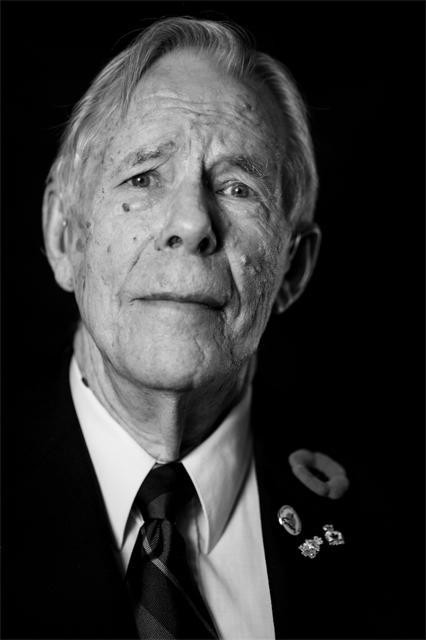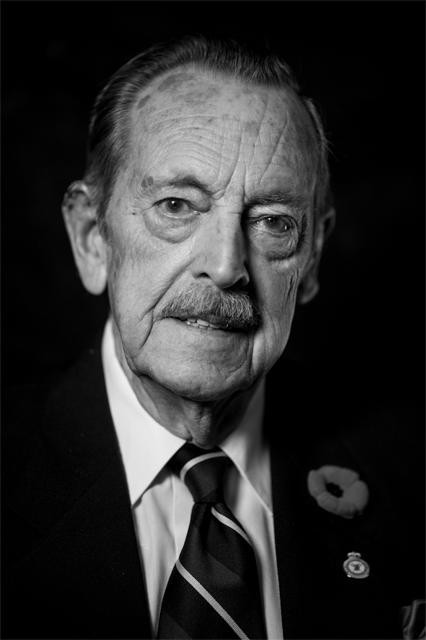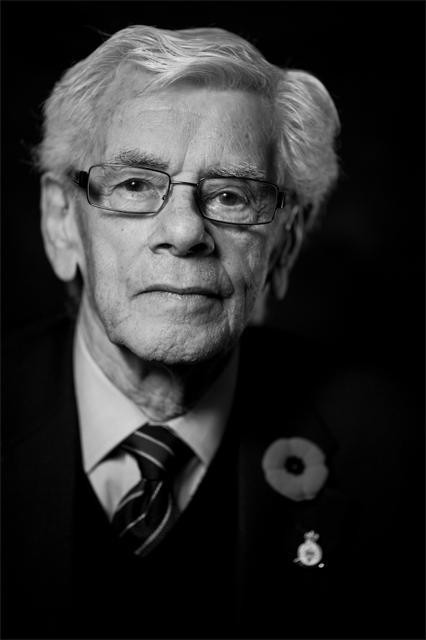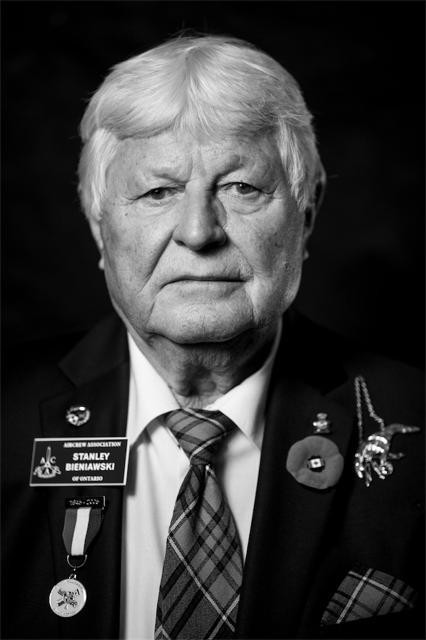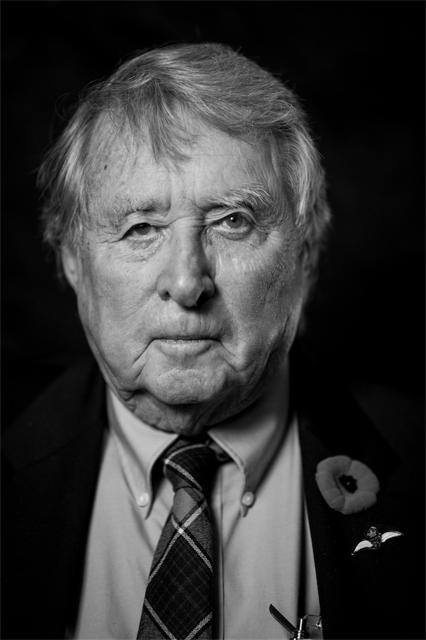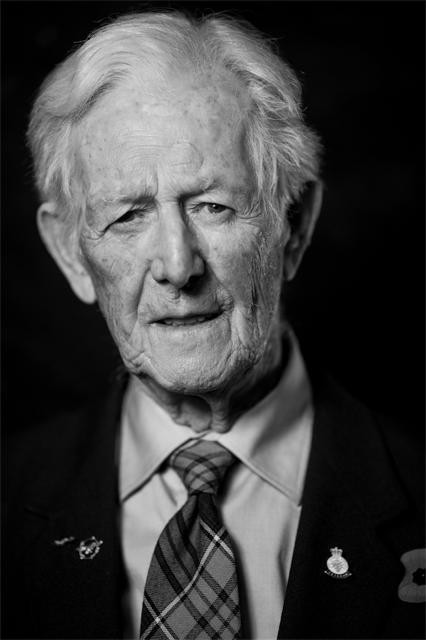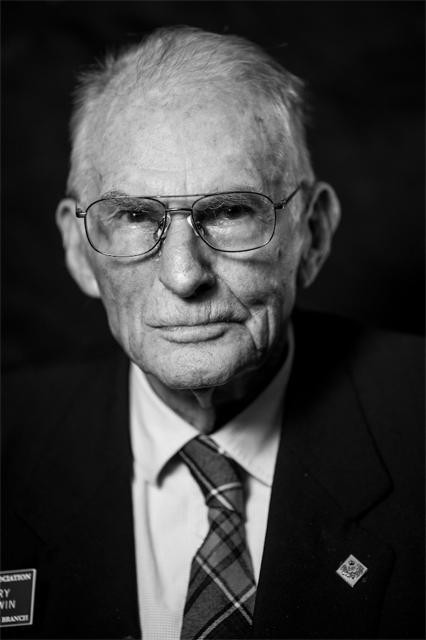Toronto-based photographer Liam Maloney is no stranger to conflict. Over the last few years he’s spent time documenting refugee life in the Middle East and East Africa, and observing the toll that conflicts in Somalia and Libya have taken on its people. For Remembrance Day, his new series Per Ardua (Latin for “through adversity”) sees his focus turn from the difficult lives of civilians living through war to a series of portraits of WWII veterans of the Royal Canadian Air Force, complimented by quotes about who they will be remembering on November 11. We called him up to discuss his project.
Advertisement
VICE: How did the idea for this series come about?
Liam Maloney: I’ve always had a fascination with airmen; I thought it was the craziest role you could take back in WWII. They definitely had the highest casualty rates. I supposed it was seen as more of a glamorous thing too; the airmen had a bit more swagger than the navy or army. They were also some of the only people who were continuously in combat from the opening salvos of the war, right through to the end. They suffered tremendous losses, if you went on a tour your chances of making it through without getting shot down, killed, injured or captured were very low. It was incredibly dangerous.And how did that fascination turn into this project?
I found a bunch of old photos at a junk shop—they were all Canadian pilots, navigators, air gunners and bomb aimers—and there was no identification in the photos at all. I was trying to figure out who these people were. I reached out to a couple of older folks I knew to get some details and one of them invited me to come to one of their air crew association meetings. I went and brought a simple setup and asked a few of them if they would sit for a picture and asked who they would be remembering on November 11.The quotes you got were really powerful, what was it like shooting these guys?
I had a tremendous amount of respect for what they did. I was struck by their sense of fraternity, seeing them all get together and sharing their stories, and just listening to them talk about the history they shared. Seeing the bond that they had with each other and their lifelong connection to what they did in the war really affected me. I don’t know if we have the same kind of connection to our own sort of groups and gangs that these guys do.
Liam Maloney: I’ve always had a fascination with airmen; I thought it was the craziest role you could take back in WWII. They definitely had the highest casualty rates. I supposed it was seen as more of a glamorous thing too; the airmen had a bit more swagger than the navy or army. They were also some of the only people who were continuously in combat from the opening salvos of the war, right through to the end. They suffered tremendous losses, if you went on a tour your chances of making it through without getting shot down, killed, injured or captured were very low. It was incredibly dangerous.And how did that fascination turn into this project?
I found a bunch of old photos at a junk shop—they were all Canadian pilots, navigators, air gunners and bomb aimers—and there was no identification in the photos at all. I was trying to figure out who these people were. I reached out to a couple of older folks I knew to get some details and one of them invited me to come to one of their air crew association meetings. I went and brought a simple setup and asked a few of them if they would sit for a picture and asked who they would be remembering on November 11.The quotes you got were really powerful, what was it like shooting these guys?
I had a tremendous amount of respect for what they did. I was struck by their sense of fraternity, seeing them all get together and sharing their stories, and just listening to them talk about the history they shared. Seeing the bond that they had with each other and their lifelong connection to what they did in the war really affected me. I don’t know if we have the same kind of connection to our own sort of groups and gangs that these guys do.
Advertisement
I think if you talk to any veteran, names are so important. Like that guy Terry Goodwin, his brother was killed in a flying accident during the war. He was very careful to spell out his full name, because really, that’s all we have left after 60 years on. We know how old they were when they died, we might now what branch of service they were in, but we don’t really know the story and it’s up to these guys to keep these stories alive. And it’s up to us, in a way. A lot of these guys are getting pretty old, there’s going to be a time soon when there are no people who lived through WWII left alive to tell us what it was like and what they went through, and who they remember, and what they were like, and I think it’s important to capture those memories.Some of these guys did multiple tours in a bomber aircraft thousands of feet above the ground being shot at at night, watching their friends in other aircraft get shot down around them. They were on a crew of between seven and ten people and that was your crew. That’s who you drank with, who you cried with. Those were the people who got you through this terrible experience. It’s amazing to see even today how deep those bonds are.Earlier you mentioned that romantic idea of airmen, that idea of these badass, cavalier dudes. It must have been interesting to get the unglorified, real side of their story.
Definitely, there’s a great poem "Dolce et Decorum Est" written in WWI about how the idea that it is sweet and honorable to die for one’s country is a great lie. Any of these guys will tell you what a lie that is. Even today, you just have to look at images of rebels in Libya. The way they dress, it’s like they were taking their cues from Hollywood. That flamboyant, sartorial fighting look is something that has a lot of allure for young men, especially. It’s unfortunate because the reality is so horrible.
Definitely, there’s a great poem "Dolce et Decorum Est" written in WWI about how the idea that it is sweet and honorable to die for one’s country is a great lie. Any of these guys will tell you what a lie that is. Even today, you just have to look at images of rebels in Libya. The way they dress, it’s like they were taking their cues from Hollywood. That flamboyant, sartorial fighting look is something that has a lot of allure for young men, especially. It’s unfortunate because the reality is so horrible.
Advertisement
It seems like there’s an unspoken rule for that era that you don’t talk about how shitty war can be.
A lot of old veterans never really spoke about their experiences after the war, they kept it to themselves or kept it within the walls of legion halls across the country, where, after a few brandies, they would finally break down or talk about their experiences of the people they missed or lost. They really controlled that narrative pretty tightly and it wasn’t considered decent to discuss the horrors of war at that time. Now I doubt you’d find many veterans interested in glorifying war, if any. But I wouldn’t want to speak for them.Any final words about this series?
I hope that people can consider for a moment what the senior sitting next to them on a subway, or walking past them in the park might have done, the sacrifice that they or their friends might have made. Maybe they could think of their own relatives, and all of the stories that are out there that are not being fully told, and maybe consider talking to some of these people and collecting these narratives. I think they’re important, and fascinating. They’re troubling but they give us reasons to avoid entering into conflict again.
A lot of old veterans never really spoke about their experiences after the war, they kept it to themselves or kept it within the walls of legion halls across the country, where, after a few brandies, they would finally break down or talk about their experiences of the people they missed or lost. They really controlled that narrative pretty tightly and it wasn’t considered decent to discuss the horrors of war at that time. Now I doubt you’d find many veterans interested in glorifying war, if any. But I wouldn’t want to speak for them.Any final words about this series?
I hope that people can consider for a moment what the senior sitting next to them on a subway, or walking past them in the park might have done, the sacrifice that they or their friends might have made. Maybe they could think of their own relatives, and all of the stories that are out there that are not being fully told, and maybe consider talking to some of these people and collecting these narratives. I think they’re important, and fascinating. They’re troubling but they give us reasons to avoid entering into conflict again.
